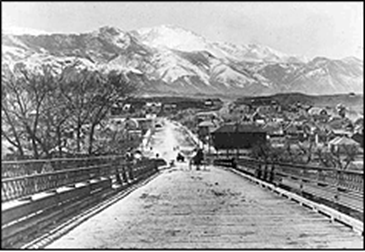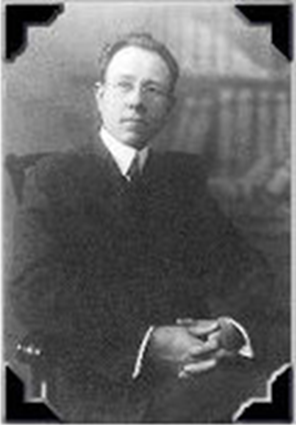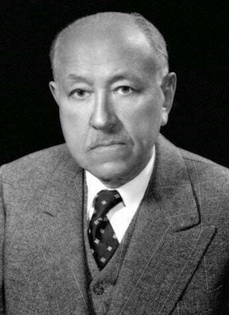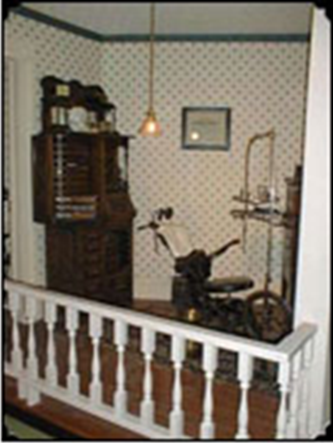History of Dentistry in the Pikes Peak Region
Long before the turn of the century, it was evident that Colorado Springs was to be one of the largest cities in the state. After the state’s outstanding health and recreation center was published nationally, the city quickly established an international reputation which added luster to its rapidly developing cosmopolitan nature. A large number of dentists and physicians migrated to this health center.
Organized Dentistry
On May 15, 1902, a group of dentists met to establish the El Paso County Odontological Society and to adopt the Code of Ethics of the “National Dental Association.”
Number of Member Doctors: Eighteen.
May 15, 1902 - a group of dentists met in Room 3 of the El Paso Bank Building, Dr. W. K. Sinton’s office to form the El Paso County Odontological Society for the advancement of the profession of dentistry and for mutual benefit. These officers were chosen: president, Dr. W.K. Sinton; vice-president, Dr. George Y. Wilson; secretary, Dr. D.A. Johnston; treasurer, Dr. J. Allen Smith. These officers and following dentists were the charter members of the society: Drs. William Bartlett, F.C. Chamberlain, Henry B. Hayden, Frederick S. McKay, A.B. Baker; W.A. DeBerry, Frank Gray, Clinton A. Downs, E.W. Thompson, W.W. Flora, John Grannis, H.L. Morehouse, J. Burton, and William Fowler.

Courtesy of the Colorado Springs Pioneers Museum
May 29, 1902 - the first regular meeting
Speaker: Dr. Frederick S. McKay
Topic: “A Plea for the Less Frequent Use of Arsenic for Devitalization of the Dental Pulp”
October 14, 1904 - the first annual meeting
After that, the dentists met at 3 p.m. on Saturday afternoons in a dentist’s office.
Beginning in 1904, the monthly meetings were held at various hotels in the city.
October 13, 1905 - the second annual meeting at the Alamo Hotel
Topics and presenters: “Indians” by Dr. Edgar W. Thompson
“Dental Recreations” by Dr. W. K. Sinton
“The Use of a Club in Dentistry” by Dr. Isaac Burton.The Discovery of Fluoride
Colorado Springs played a leading role in a scientific detective story that led to the fluoridation of public water systems. The original members of the El Paso County Odontological Society promulgated one of history’s most significant scientific dental investigations – the relationship of mottled enamel (also known as Colorado brown stain) and fluoridated water to the reduction of dental decay.
- In 1902 - recognized the enamel stain which afflicted the teeth of many natives of Colorado Springs and authorized the first systematic investigation of the enamel stain.
- Late 1902 - letters sent to dentists throughout the Rocky Mountain area to identify other stain-afflicted areas. Due to sparse replies, very little information was obtained.
- On May 11, 1906 - Dr. Walter A. Brown addressed the subject once again.
- May 8, 1908 - Dr. McKay began his investigation of mottled enamel. According to some reports, he crushed area rock samples to prove that water could dissolve the fluoride-containing minerals.

Courtesy of the Colorado Springs Pioneers Museum
Dr. Frederick McKay
- 1874 - born in Lawrence, Massachusetts
- 1900 - graduated from the University of Pennsylvania Dental School
- 1901 - relocated to Colorado Springs. Dr. McKay was intrigued by the number of patients whose teeth were stained with white or brown spots; and in severe cases, the enamel was pitted. He was distressed by the apathy of the rest of the profession to do something positive about correcting this cosmetic problem.
- 1905 - moved to St. Louis to specialize in orthodontia. While in St. Louis he noticed the brown stain was not prevalent in that region.
- 1908 - returned to Colorado Springs due to health reasons and his investigation of the stain continued
- May 8, 1908 - Dr. McKay and the El Paso County Odontological Society presented a patient at the Colorado State Dental Association meeting to illustrate and to promote interest in the brown stains found on teeth of children born in Colorado Springs, Colorado City, and Manitou Springs. Except for learning about some other areas where the stain could be found on locals’ teeth, little interest was manifested by those at the meeting.
- December 11, 1908 – The society formed a committee consisting of Drs. McKay, Fleming, and Burton to examine the teeth of the public-school children in the Colorado Springs area for evidence of the “Colorado stain.”
- January 8, 1909 - the school board granted permission to the committee to examine the teeth of the children; and the board approved $21.00 to cover the cost of the examination and the record cards.
- 1909 - During the examinations Drs. McKay and Burton moved from desk to desk, noting the condition of the teeth and indicating the degree of stain. They correlated the examination information with questionnaires completed by the children’s parents relating to birthplace, places of residence, and the child’s age when s/he had moved to Colorado Springs.
- Spring 1909 - the two dentists inspected 2,945 children and were astounded to discover that 87.5% were afflicted with some degree of stain or mottling; and all those afflicted were native to the Pikes Peak region.

There were many theories for the cause of the stain affliction:
- poor nutrition
- eating too much pork
- drinking milk from local cows
- radium exposure
- calcium deficiency in the drinking water
- childhood diseases
in 1908 Dr. McKay corresponded with Dr. G.V. Black, the dean of the Northwestern University Dental School in Chicago, about the unique Colorado Brown Stain. Dr. Black became interested and began histological investigations into the problem.
In 1909 Dr. Black traveled to Colorado Springs to see the stained enamel firsthand. Dr. Black’s interest in the phenomena raised the problem to a level of scientific importance which created an increasing interest in the dental profession.
From this time on, Dr. McKay traveled the United States, performing examinations and charting conditions in ten states and made personal examination in two European countries. He prepared more than 40 papers on the subject for publication and presentation to scientific organizations. Dr. McKay used mostly his own funds for his research. The only financial support he received was $125 from the city of Colorado Springs (both the city and the county pledged $500, but neither made the full funds available); $150 from the Colorado State Dental Association while Dr. McKay was CSDA president; and the largest sum was $800 from the American Dental Association in 1912.
In 1917 Dr. McKay moved to New York City, where he specialized in periodontics until 1940.
He relocated to Colorado Springs in 1940 and continued his practice in periodontics. He died in Colorado Springs on August 22, 1959.
Summary
Although Dr. McKay was initially attracted by the cosmetic discoloration and pitting of the tooth enamel of some Colorado Springs natives, his investigations further discovered that people with stained teeth also had fewer cavities. It was not until 1931 that it was finally determined that the cause of the brown stain was from the high concentration of the fluoride ion in the Colorado Springs public drinking water. Colorado Springs fluoride was naturally derived from Pikes Peak’s rock formations. The community water shed contained deposits of cryolite, a mineral containing fluorine. As the water from rain or snow trickled down the fluoride-containing rock formations, the water picked up the fluoride ion.
Population studies later confirmed the benefits of fluoride. One study compared Colorado Springs youngsters to a matched group of children living in Boulder, Colorado, where there was considerably less fluoride in the drinking water. The study showed a significant reduction in cavities in the local children’s teeth.
Thanks to Dr. McKay and the pioneering dentists of Colorado Springs, public water fluoridation is considered the most efficient and cost-effective dental caries prevention measure available. In 1962, the American Dental Association stated, “The fluoridation of public water supplies is a safe, economical, and effective measure to prevent dental caries. It has received the unqualified approval of every major health organization in the United States and of many other countries.” Besides the ADA, the American Medical Association, the Academy of Pediatrics, and the World Health Organization have supported community water fluoridation. In 1999, The Centers for Disease Control listed fluoridation of drinking water as one of the ten great public health achievements. Water fluoridation of community water supplies is the single most effective public health measure to prevent tooth decay and to improve oral health for a lifetime.
The Pioneer Museum located in downtown Colorado Springs created an exhibit, “The Story of Us.” Dr. McKay’s studies are listed under the letter “F” for fluoridation. “. . .McKay’s notes and numerous glass slides of his research activities are part of the museum’s collection.” (https://cspm.org/exhibits/the-story-of-us/)A Legacy of Service to the Community
In 1909, three community-health programs were placed in operation:
- The local dentist would provide free examinations and reports on all public-school children’s mouth and teeth.
- The dentists would cooperate in the establishment of a dental clinic for the indigent population.
- They would conduct dental hygiene classes for parents, teachers, and children. The most immediately productive effort was the clinic for indigent students at the high school.
Originally, the clinic was staffed by volunteer local dentists.
In 1914, however, Dr. A.C. Dreihaus was appointed as full-time resident dentist, with the society compensating him for his services.
In 1915 the Colorado Springs Health Department assumed financial responsibility for the clinic.
Today, society members are still involved in the health of the city’s residents and provide low- or no-cost dental care through partnerships and events such as Colorado Mission of Mercy (COMOM), Give Kids a Smile (GKAS) and care days.

Courtesy of the Colorado Springs Pioneers Museum
Colorado Springs Lady Dentists
From the Colorado Springs Dental Society November 6, 1924, Minutes:
report of the Membership Committee was given to the chairman, Dr. Wells, who read application for membership for Dr. Virginia Garth. Dr. Wells moved that the application be accepted and placed on file to be acted upon at the next meeting. The motion was seconded by Dr. Cogswell and carried by the Society.
From the December 4, 1924, Minutes:
…Dr. Wells further reported that the application of Dr. Garth was due for a vote. In the balloting that followed, Dr. Garth was unanimously elected to membership in the Society.
So, Dr. Virginia Garth became the first lady dentist to be a member of the Colorado Springs Dental Society and apparently the first lady dentist to practice in Colorado Springs.
- February 2, 1903 - Dr. Garth was born, in Colorado Springs. Her father, Dr. Samuel Garth, practiced dentistry here.
- In 1923, she graduated from the University of Denver College of Dentistry.
- In 1924, she began practicing dentistry in 1924 with her father, but then she attended the International School of Orthodontia in Kansas to specialize in orthodontia. Dr. Garth was also a faculty member of Western Dental College in Kansas City for five years.
- In 1931, Dr. Garth returned to Colorado Springs and maintained her downtown orthodontia dental practice on the seventh floor of the Exchange National Bank Building until 1973.
- In 1990, Dr. Garth passed away and had bequeathed 300 acres of land bounded by Austin Bluffs Parkway on Pulpit Rock to the University of Colorado at Colorado Springs.
Dr. Garth Trembly was the only lady dentist to be a member until 1979 when Dr. Mary Anna Purinsh was elected to membership on February 6, 1980.
Dr. Tracie Keller was elected secretary-treasurer on May 3, 1990. She advanced through the chairs of office to become the first lady president of the CSDS on June 1, 1992.
Currently, there are 148 lady dentists in the Pikes Peak region, which is 29% of practicing dentists.
For More Historical Information
Sources for this website include History of Dentistry in Colorado 1859 – 1959 by William A. Douglas; Colorado Springs Dental Society records and minutes; Newport in the Rockies by Marshall Sprague; The Gazette Telegraph archives at Penrose Library. More historical information regarding dentistry, medicine, and pharmacy in the Pikes Peak region is available through these sources:
Colorado Springs Pioneers Museum
215 South Tejon Street
Colorado Springs, CO 80903
Pikes Peak Library District
Penrose Public Library
20 North Cascade Avenue
Colorado Springs, CO 80903
1 South 24th Street
Colorado Springs, CO 80904

